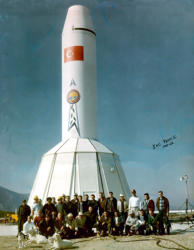HISTORY - Page 45
Other matters of immediate concern involved the size of the program and the employment concept. Before
these were resolved, a considerable expense was incurred because of the frequency requirements to
effect over-all program revisions. At the outset, it appeared that the JUPITER would be a four-squadron
program, and that each squadron would be mobile and capable of periodic movement to alternate sites to
complicate the enemy attack problem. In August 1958, however, it was learned that the Secretary of the
Air Force had designated $225 million for FY 1959 in the JUPITER portion of the IRBM program rather than
$299 million that had been programmed by ABMA. This meant that only a three-squadron program was
planned, as opposed to the four; although it was October before this fact was known. Almost paralleling
this action was a USAF notification on 12 November 1958 to the effect that tactical mobility was no longer
considered a part of the program. A clue to this situation had been received some two months before when
SAC changed the deployment plans for the first squadron to two launch positions of three emplacements
each. All through the time frame covered in these changes, ABMA had been forced to program and
reprogram because of the piecemeal way the information came to the Agency. With regard to the mobility
part, termination costs for contracts already in force were rather high. Thus, in reality, two years had
elapsed before ABMA could determine the exact direction that the JUPITER program would pursue. After
that, the requirement still existed to conclude the government-to-government and technical agreements.
This had a serious effect on ABMA training plans and facilities
60
.
_____________________________







60. Hist, ABMA, Jul-Dec 58, pp. 8-11; Major Decisions Affecting the /JUP/ Prog.



Jupiter SM-78 Weapon System
I&C Team 2, Çigli AB, Turkey 1961-1962 Chrysler Corporation Missile Division

HISTORY - Page 45
Other matters of immediate concern involved the size
of the program and the employment concept. Before
these were resolved, a considerable expense was
incurred because of the frequency requirements to
effect over-all program revisions. At the outset, it
appeared that the JUPITER would be a four-squadron
program, and that each squadron would be mobile and
capable of periodic movement to alternate sites to
complicate the enemy attack problem. In August 1958,
however, it was learned that the Secretary of the Air
Force had designated $225 million for FY 1959 in the
JUPITER portion of the IRBM program rather than $299
million that had been programmed by ABMA. This
meant that only a three-squadron program was
planned, as opposed to the four; although it was
October before this fact was known. Almost
paralleling this action was a USAF notification on 12
November 1958 to the effect that tactical mobility was
no longer considered a part of the program. A clue to
this situation had been received some two months
before when SAC changed the deployment plans for
the first squadron to two launch positions of three
emplacements each. All through the time frame
covered in these changes, ABMA had been forced to
program and reprogram because of the piecemeal
way the information came to the Agency. With regard
to the mobility part, termination costs for contracts
already in force were rather high. Thus, in reality, two
years had elapsed before ABMA could determine the
exact direction that the JUPITER program would
pursue. After that, the requirement still existed to
conclude the government-to-government and
technical agreements. This had a serious effect on
ABMA training plans and facilities
60
.
_____________________________
60. Hist, ABMA, Jul-Dec 58, pp. 8-11; Major Decisions Affecting the /JUP/ Prog.





















